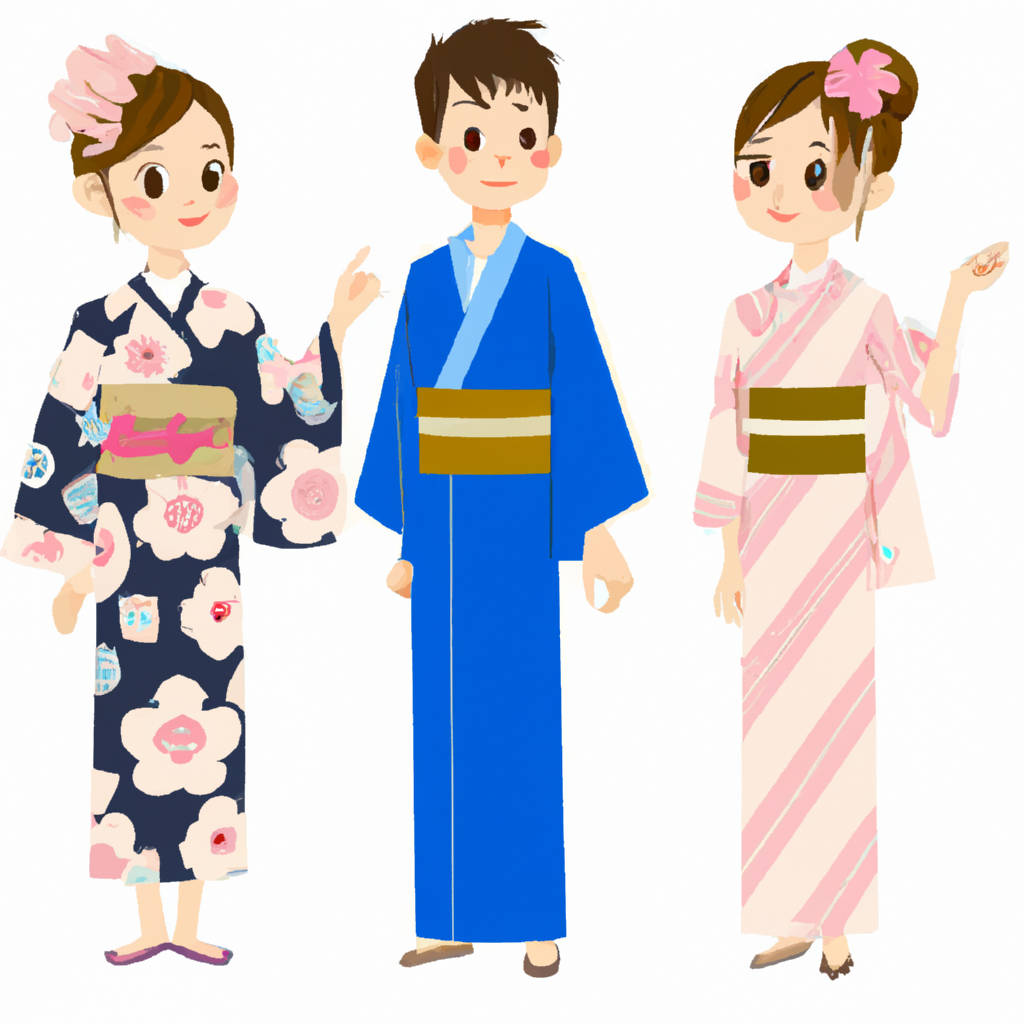A Yukata is a traditional Japanese garment that is often worn during summer festivals and other casual events. While it may seem daunting to wear one if you’re unfamiliar with the process, it’s actually quite simple once you know the steps. The first step in wearing a Yukata is to put it on like a robe, letting it fall to your ankles. Ensure the left side is over the right, as the opposite is reserved for funerals. Next, you’ll need to wrap a thin sash, called a Koshihimo, around your waist and tie it at the back. This helps hold the Yukata in place. After that, adjust the Yukata’s collar so it sits comfortably around your neck. The collar should not be tight but should remain close to the neck.
The next step involves the Obi, which is a broader belt worn over the Koshihimo. The Obi should be tied in a square knot at the back. Finally, ensure that the Yukata is neat and straight, with no creases or folds. The Yukata should fit comfortably and not restrict your movements. It’s important to remember that while wearing a Yukata, it’s best to adopt a respectful and polite attitude, as this is a part of the tradition and culture associated with this attire. Wearing a Yukata is not just about the garment itself, but also about appreciating and respecting Japanese culture. It’s an experience that can provide a unique insight into Japan’s rich history and traditions.

Putting on Yukata
Putting on a Yukata, a traditional Japanese garment, is an art that involves intricate steps and respect for the culture. The Yukata, typically made of cotton or synthetic fabric, is worn during the summer months and at festivals to celebrate the Japanese tradition. To wear a Yukata, the first step is to hold it at your shoulders, ensuring that the middle seam at the back lines up with your spine. It should be ankle-length, so adjust accordingly if necessary. Next, wrap the right side over your body, followed by the left side, which is the standard practice in Japanese culture. The left side should always be on top when wrapping around your body to signify living status as the opposite is reserved for funerals.
After this, secure the Yukata with a Koshihimo, a sash, tied around your waist. This is done by folding the excess fabric in at the waist to adjust the length. The Koshihimo is then wrapped around your waist and fastened securely, but not too tight. Once the first sash is secured, an additional longer, wider belt known as an Obi is tied around the waist for women, adding an aesthetic appeal. For the Obi, there are numerous ways to tie it, with the butterfly knot being a popular style. Men’s Yukata, on the other hand, typically use a thinner belt, tied simply at the back.
The final touch in wearing a Yukata is donning traditional footwear, usually Geta or Zori sandals, and optionally a small bag or purse. It’s important to note that the process of putting on a Yukata not only symbolizes respect for Japanese tradition but also serves as an expression of one’s style and personality. The patterns, colors, and how you accessorize can vary greatly, allowing room for individual creativity while still appreciating the cultural significance.
Securing Garment
Securing garments is a critical aspect of both retail operations and individual wardrobe management. Retail stores, especially those dealing with high-end fashion, must implement effective security measures to protect their valuable merchandise from theft and damage. These measures may include the use of security tags, surveillance cameras, and locked display cases. On the individual level, securing garments involves taking appropriate steps to safeguard your clothing from damage, loss, or theft.
This might entail storing valuable or sentimental pieces in secure, climate-controlled areas to prevent deterioration. When travelling, one should use suitcases with locks and frequently check their belongings in public places to ensure they are still in possession of their garments. Moreover, when using laundry services, it’s crucial to verify that the service provider is trustworthy and reliable, to avoid instances of misplaced or stolen clothing. Therefore, securing garments, whether for personal use or in a retail setting, is an essential practice that requires meticulous attention and vigilance.

Tying Obi Knot
Tying an Obi knot is a traditional Japanese practice that is deeply rooted in the culture and history of the country. The Obi knot is part of the traditional Japanese attire known as Kimono and is often tied around the waist. The elegance and sophistication of an Obi knot are undeniable, and its beauty is highly appreciated in Japan, where it is seen as a symbol of etiquette and refinement. There are various types of Obi knots, each with its unique method of tying and specific occasions where they are worn. Some popular types include the Taiko, Butterfly, and Drum knots.
The process of tying an Obi knot is an art form in itself, requiring patience, skill, and a deep understanding of the cultural significance behind it. The process begins with the selection of the appropriate Obi, which can be a daunting task given the wide array of colors, patterns, and fabrics available. Once the Obi is chosen, the actual tying of the knot begins. This process can be intricate and time-consuming, but the end result is a beautifully tied Obi knot that enhances the overall appearance of the Kimono.
Historically, the Obi knot was a symbol of a woman’s marital status and social standing. However, it has evolved over the years to represent a broader scope of meanings, often associated with the wearer’s personal style and fashion sense. Despite the changing times, the practice of tying an Obi knot continues to hold a special place in Japanese culture. It is not just a mere accessory to the Kimono but a vital element that completes the traditional attire. Thus, the art of tying an Obi knot remains an important tradition that is passed down from generation to generation, preserving the rich cultural heritage of Japan.
Folding Techniques
Folding techniques encompass an array of methods utilized in diverse fields ranging from the culinary arts to mathematics. These techniques are not just limited to the physical act of bending an object onto itself, but also include the theoretical and computational aspects of folding. For example, in the culinary realm, chefs utilize specific folding techniques to incorporate air into batter or dough to create a light, fluffy consistency. On the other hand, origami, the Japanese art of paper folding, employs intricate folding methods to transform a flat sheet of paper into a three-dimensional sculpture. Furthermore, in the field of mathematics, folding techniques are studied in the realm of geometry and topology, where the properties and dimensions of shapes are explored.
Even in the world of fashion, folding techniques are used to create unique patterns and designs in fabrics. In the technology sector, engineers and scientists leverage folding techniques to develop compact and portable products, such as foldable phones and laptops. In the field of architecture, folding techniques have been used to design flexible and efficient spaces. Overall, folding techniques are a fascinating and multifaceted topic, with applications in a multitude of disciplines. They not only provide practical solutions to everyday tasks but also open up avenues for creativity and innovation. Despite their apparent simplicity, the science and art of folding are complex and have profound implications in our lives.

Adjusting Fit
Adjusting fit refers to the process of altering or changing something to ensure it aligns seamlessly with the existing structure or system. This could be applicable in various scenarios, such as modifying a piece of clothing to fit a body shape, tweaking a business strategy to match the current market trends, or even adjusting lifestyle habits to align with health goals. The process of adjusting fit often involves careful evaluation of the current state and the desired outcome, followed by the implementation of necessary alterations or modifications. The importance of adjusting fit cannot be overstated as it aids in achieving optimal performance and results in any given situation.
Whether it’s a piece of machinery that needs tweaking for optimal functioning or a new idea that needs to be modified to align with the existing framework, the process of adjustment is essential. It’s also crucial to remember that adjusting fit is not a one-time process but a continuous one, requiring constant assessment and modification. This is because conditions, circumstances, and requirements often change over time, necessitating further adjustments to maintain alignment and efficiency. Therefore, the concept of adjusting fit is a dynamic and ongoing process that plays a pivotal role in ensuring the success and effectiveness of various operations and endeavours. So, whether in personal life or professional settings, the ability to adjust fit is an invaluable skill that can lead to improved outcomes and greater satisfaction.
Creating a Neat Finish
Creating a neat finish is an integral part of any task or project. It is the final touch, the polished look that brings together all the elements of your work into a cohesive, appealing result. Whether it’s crafting a piece of furniture, painting a room, baking a cake, or even writing a report, a neat finish can make a significant difference in the overall perception of your work. Achieving a neat finish requires meticulous attention to detail, patience, and a dedication to excellence. It’s about taking the extra time to smooth out any rough edges, double-check your work, and ensure that every element is in its proper place.
The process may seem tedious and time-consuming, but the end result is always worth it. A neat finish not only enhances the aesthetic appeal of your work, it also reflects your commitment to quality and professionalism. It shows that you take pride in what you do and are willing to go the extra mile to ensure your work is the best it can be. It’s not just about making a good impression, but also about achieving a sense of satisfaction and accomplishment in knowing you’ve done your best. In conclusion, a neat finish is more than just a final touch, it’s a testament to your skill, dedication, and passion for your work.

Styling Accessories
Styling accessories are essential elements in the fashion world that add a unique touch to every outfit, enhancing one’s individual style and personality. They include a wide range of items such as jewelry, hats, belts, scarves, handbags, shoes, sunglasses, and even hair accessories. These additions can transform a basic ensemble into a fashion-forward look, providing depth and complexity to every outfit. Not only do they offer a way to express one’s personal style, but they also have the potential to alter the vibe of an outfit completely.
Suppose a person is wearing a simple black dress. By adding a statement necklace, fashionable handbag, and a pair of stylish heels, the dress goes from being casual to chic and sophisticated. Similarly, a man in a basic white shirt and jeans can upgrade his look with a leather belt, a wristwatch, and a pair of sleek sunglasses. Styling accessories possess the ability to change the overall feel of an outfit, making them an indispensable part of any wardrobe. Furthermore, they can also be used to highlight certain features or to draw attention away from others. For instance, a brightly colored scarf could be used to draw attention to the face, while a pair of oversized sunglasses may be used to hide tired eyes.
With the vast variety available in the market, styling accessories offer endless possibilities for creativity and personal expression in fashion. They are a testament to the idea that dressing up is not just about clothing, but also about the details that complement and enhance those clothes. Whether one prefers a minimalist style with dainty, understated pieces or a bold, eclectic look with chunky, eye-catching items, styling accessories can cater to every aesthetic, making them a significant aspect of fashion and personal style.

